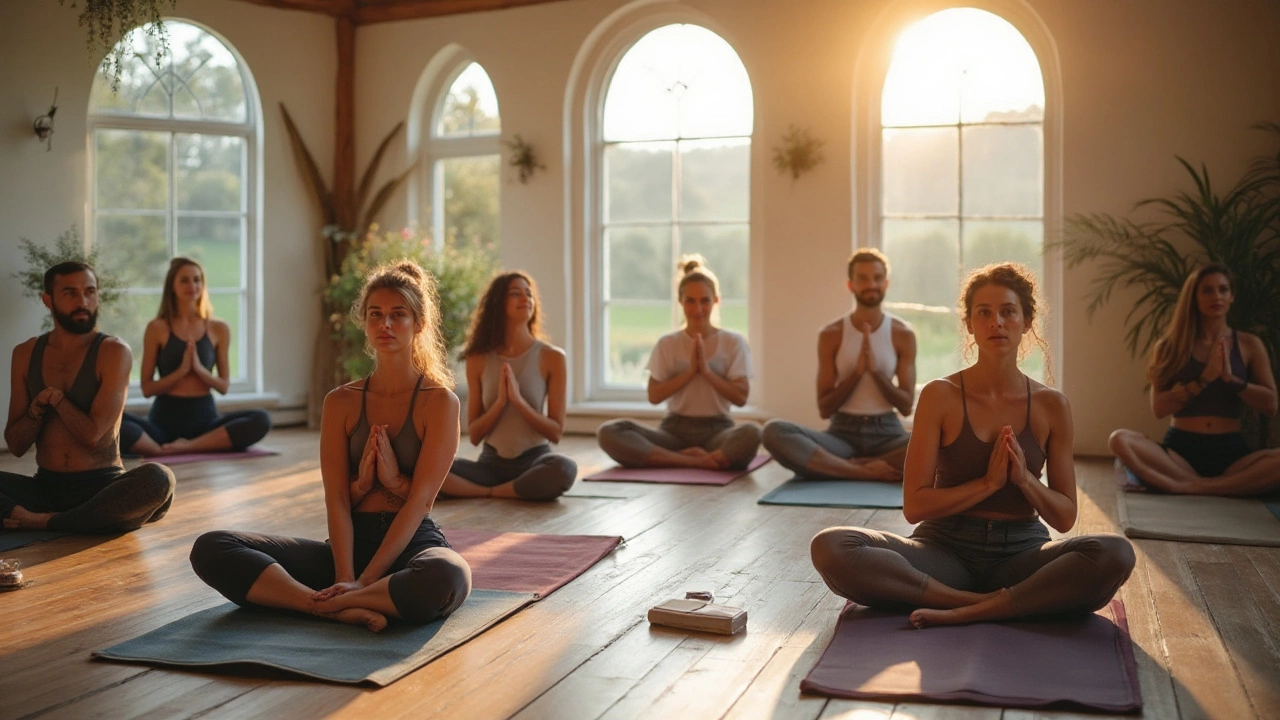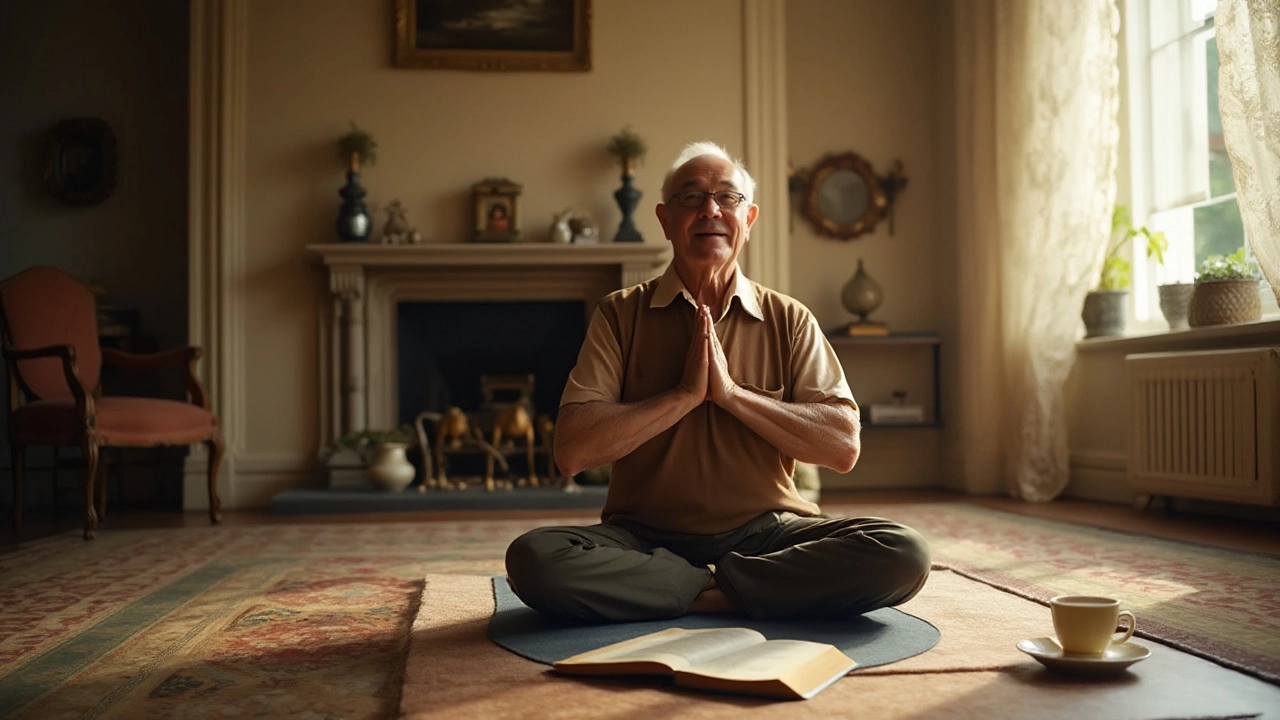
Yoga has been a path of self-discovery and healing for centuries, guiding practitioners toward inner peace and physical vitality. One intriguing concept in yoga is the 'magic number,' a term whispered among dedicated yogis that speaks to the ideal frequency and duration of practice.
This magic number is thought to unlock profound benefits, enabling a deeper connection to the self and the universe. But what is this number, and how do we find it? Exploring the ancient practices and adapting them to our modern lives can reveal insights unique to each yogic journey.
Join us as we delve into the historical roots, philosophies, and practical tips to help you discover your magic number in yoga. Whether you're a seasoned practitioner or new to the mat, uncovering this number could be the key to elevating your practice and harnessing its full potential.
- Understanding the Concept of the Magic Number
- Historical Context and Philosophical Insights
- Benefits of Regular Yoga Practice
- Personalizing Your Yoga Journey
- Tips to Implement the Magic Number
- Balancing Mind, Body, and Spirit
Understanding the Concept of the Magic Number
The concept of the 'magic number' in yoga echoes an ancient, profound connection between body and spirit, whispering promises of harmony and discovery. This idea isn't about a mystical cipher but rather a tangible discipline that balances regularity and intensity in yoga routine. Historically, yoga sages spoke of practicing daily to unlock the full spectrum of its transformative powers. It resonates like the heartbeat of our daily lives—rhythmic, consistent, and vital. For many practitioners, the 'magic number' signifies how many days of practice per week offer optimal benefits, tailored to one's lifestyle and needs. This personalized magic number is discovered through experience, reflection, and a deepening understanding of one's body and mind.
Interestingly, ancient yogic texts like the Yoga Sutras of Patanjali emphasize the significance of consistency. The text suggests that steady, sustained practice over a long period with sincere dedication bears extraordinary fruits. Some yoga traditions recommend practicing at least six days a week, suggesting that daily engagement enhances mastery and sustenance of the calm achieved in practice. Such dedication aligns with the principle of Abhyasa (practice), one of the essential pillars in yoga philosophy. The regularity instills not just discipline but nurtures an emotional and mental equilibrium. By embracing this magic number, practitioners often find that their physical agility, concentration, and overall wellness improve remarkably.
Is this number about time spent on the mat too? Absolutely. Many experts propose that thirty minutes of focused practice can be considerably more effective than sporadic, lengthy sessions. This balance encourages practitioners to integrate yoga seamlessly into daily routines. Optimal yoga practice is akin to a dialogue with oneself, assessing daily changes in energy and emotion, to align practice with what is personally beneficial. A study published in 'The Journal of Behavioral Medicine' supports this notion, showing improved mental health outcomes with routine yoga practice of moderate duration. The nuances of each individual's path suggest that while a broad framework can be recommended, personalization is key. Competency in yoga arises not merely from repetition but from mindful engagement and personalization of practice.
'If you practice yoga once a week you will change your mind. If you practice twice a week you will change your body. If you practice every day, you will change your life.' - Ancient Yogic WisdomAmong the multitude of yoga styles, each offers different challenges and revelations, hinting that the magic number can't be a one-size-fits-all. Some practitioners may discover their magic number in daily Hatha sessions, while others might find peace and progress in less frequent, more vigorous Ashtanga practices. It's a path woven with self-exploration where feelings of satisfaction and harmony indicate that a practitioner has found their own magic number. Ultimately, this number becomes a guide, steering practitioners toward their goals and maintaining the delicate balance between effort and surrender.
Historical Context and Philosophical Insights
The pursuit of understanding our connectedness through yoga dates back thousands of years. Originating in ancient India, yoga is both a philosophical system and a practical methodology designed to achieve harmony between the mind and body. The profound insights of the sages were documented in texts like the Yoga Sutras of Patanjali, written around 200 BCE. These sutras form the cornerstone of classical yoga philosophy and provide invaluable guidance on how to live a balanced life. Yoga Sutras describe not only the eight limbs of yoga but also emphasize the importance of consistency, which can be linked to discovering one's magic number.
In these texts, the concept of 'Abhyasa' or consistent practice is frequently highlighted. Abhyasa is defined as the effort to achieve steadiness of mind and its regularity is believed to bring transformational change. This ancient wisdom underscores the value of establishing a regular yoga routine to reap holistic benefits. With this regularity, the number of sessions or time spent in practice can be seen as a symbolic 'magic number.' A popular belief among many yogic traditions is that practicing yoga for 21 consecutive days can lead to a habit transformation, mirroring Emerson's notion that 'a consistent practice is one's greatest teacher.' This sentiment is captured in modern times with the idea of forming new habits through neuroscience research.
Beyond the personal discipline and physical practices, the philosophical underpinnings of yoga offer insights into life's deeper truths. Yoga emphasizes the interconnectedness of all beings, advocating for compassion, mindfulness, and equanimity. The Bhagavad Gita, another revered text from around 500 BCE, elaborates further on the importance of duty, devotion, and practice. It encourages one to find balance through dedicated practice and consistent mindfulness. The emphasis on consistency aligns closely with finding the optimal yoga practice frequency—your magic number. This frequency does not just pertain to physical postures but extends to meditation, pranayama, and ethical living. The surrender to one's true self, as taught in the Gita, is achieved through habitual practice, reflecting both historical teachings and modern interpretations of yoga's philosophy.
Interestingly, modern science often parallels these ancient thoughts. Studies show that consistent yoga practice, determined by one's personal magic number, not only improves physical fitness but significantly enhances mental health and emotional well-being. The alignment between modern research and ancient teachings offers fascinating insights into the historical continuity of yoga's benefits. In a rapidly evolving world, these philosophical roots remind us of the timeless value of connecting with traditions that honor individuality while nurturing collective harmony.

Benefits of Regular Yoga Practice
Engaging in a regular yoga routine can yield a multitude of rewards, touching nearly every facet of life. Those who embrace this journey often speak of a serene mind entwined with a resilient body, a harmonious symphony cultivated through consistent practice. Regular yoga encourages improved flexibility, with poses that stretch muscles and expand range of motion, often reducing the risk of injury in other physical activities. This increased flexibility is not just physical; it also fosters mental pliability, guiding practitioners to approach life’s challenges with grace.
The mental benefits are equally profound. Yoga is well-known for its calming effects, helping to lower stress levels and promote a sense of peacefulness. Studies suggest that yoga can significantly decrease levels of cortisol, the body’s main stress hormone. By incorporating meditation and breathing techniques, practitioners often experience enhanced clarity and focus. This mindfulness becomes a cornerstone for mental strength, making yoga a powerful tool in managing cognitive challenges and enhancing emotional health.
"When you listen to yourself, everything comes naturally. It comes from inside, like a kind of will to do something. Try to be sensitive. That is yoga." - Petri Räisänen, renowned yoga teacher.
Yoga doesn't stop at flexibility and stress relief. It also has substantial physiological effects. Heart health can markedly improve by maintaining regular practice, as yoga can lower blood pressure, boost blood circulation, and reduce bad cholesterol. By welding together core postures with deliberate breathing, practitioners may strengthen their cardiovascular systems, enriching their holistic wellbeing in the process. There's a growing body of research evidencing yoga’s role in reducing chronic pain conditions, presenting a non-invasive choice for pain management.
Optimal yoga practice, supported by the concept of the 'magic number,' extends benefits beyond individuals. It fosters a sense of community, connecting individuals in shared experiences of growth and wellness. Group classes create environments of trust and mutual support, making the practice both personal and communal. Moreover, through its philosophical teachings, yoga imbibes a wider understanding of the self, promoting compassion and empathy towards others. This cultivates not just individual wellness but a broader social impact as well.
Statistics and Insights on Yoga Benefits
Understanding the benefits through the lens of data can be eye-opening. According to a survey by Yoga Alliance:
| Factor | Improvement |
|---|---|
| Flexibility | 86% of practitioners reported better flexibility |
| Stress Reduction | 70% attributed reduced stress levels to yoga |
| Heart Health | Low incidence of heart-related issues in regular practitioners |
These stats underscore the significant and evidence-based advantages of a consistent yoga practice. By discovering your personal 'magic number,' these benefits can be tailored and maximized to suit your unique journey. Whether it’s once a week or more frequently, incorporating yoga into your lifestyle is an investment in both current well-being and long-term health.
Personalizing Your Yoga Journey
Embarking on a yoga journey is an intimate and transformative experience, one that requires personal reflection and a willingness to explore individual needs. The path to discovering your optimal yoga practice isn’t prescriptive; it’s an evolving dance between mind, body, and spirit. Every practitioner, regardless of experience, brings a unique tapestry of background, fitness level, and wellness goals to their mat. This makes personalizing your practice not just essential, but deeply rewarding. Understanding that one size doesn't fit all is the first step toward harnessing the power of yoga in your life.
Customizing your routine means acknowledging where you are at this moment—physically, mentally, and emotionally. For some, a vigorous Vinyasa flow might be the key to unlocking energy and creativity, while for others, a gentle Yin session might be what's needed to find peace and restoration. Exploring various yoga styles and techniques can guide you to discover what resonates with your spirit. Track how your body responds and be open to modifications as your journey unfolds, ensuring you remain in harmony with your evolving self.
Embracing Flexibility in Practice
Flexibility, in both body and routine, is crucial. Let's say your schedule allows for practice three days a week—what happens if life gets busy, or your energy levels dip? Not every session has to be intense. Sometimes a brief meditation or a few restorative poses can make a significant difference and still keep your yoga routine consistent. The magic number isn’t about rigidity; it’s about adaptability—a lesson yoga generously teaches.
Consider the words of B.K.S. Iyengar, a renowned yoga visionary, "Yoga teaches us to cure what need not be endured and endure what cannot be cured."
B.K.S. IyengarHis insight emphasizes yoga’s role as a personal remedy, adaptable and enduring.
Integrating Wellness Practices
To enrich your yoga journey, think beyond the mat. Nutrition, sleep, and mindfulness all play roles in supporting your practice. Engaging with wholesome foods fuels your sessions, enhancing both stamina and concentration. Quality rest allows for recovery, which is vital in maintaining a long-term engagement with yoga. Mindfulness, whether in meditation or through deliberate self-care, strengthens the mental components of the practice, fostering inner tranquility and focus.
Personalization also extends to setting intentions. Why have you chosen yoga? Is it for stress relief, physical health, spiritual growth, or something entirely different? Your goals will guide you, so take time to reflect and reset them as needed. Documenting milestones and challenges can offer valuable insights and celebrations of growth, small and large.
Remember, the journey of yoga is uniquely yours to forge. Whether it’s dedicating time to daily practice or indulging in a weekend retreat, finding your rhythm within the tapestry of yoga will empower and illuminate your path toward holistic well-being.

Tips to Implement the Magic Number
Implementing the magic number in yoga is more of an art than a strict science, offering flexibility for each unique practitioner's journey. This powerful concept relates to identifying the right balance of practice days and duration, which can be transformative. Start by understanding that the magic number isn't fixed; instead, it's personal and adaptable. As you explore what works for you, consider factors like lifestyle, work schedules, and personal goals. A beginner may find that starting with three days a week for 30 minutes each session is ideal, while more advanced practitioners might aim for an hour-long practice, five to six days a week.
Setting realistic expectations is crucial. For those just embarking on a yoga routine, consistency is vital. The magic number might begin with just two or three sessions per week, as this rhythm can significantly impact flexibility and mental calm. An intriguing fact is that studies show practicing as little as twice a week can enhance well-being. As you build proficiency and strength, adjusting this number upwards can lead to deeper connections and improvements in various aspects of life, such as stress reduction and increased focus.
"What we find is that people often try to do too much too soon," says renowned yoga instructor Shiva Rea. "But finding a sustainable rhythm, your magic number, is what will carry you forward gently and lovingly."
Listening to your body is another critical step in uncovering your magic number. Some days, your body may call for restorative and gentle practices. On others, it might crave a more dynamic flow. Aligning with these intuitive signals helps maintain engagement and prevents burnout. Remember, yoga is a dialogue with the self, and being attuned to your body's responses is essential for growth.
Journaling your experiences can provide insights and help track progress. Jot down notes on how you feel after each session—both physically and mentally. Over time, patterns emerge, assisting you in narrowing down an optimal practice schedule. This reflective tool can guide adjustments and realignments based on personal growth or life changes. It's fascinating how documentation can illuminate your path, pinpointing the precise 'magic' in your number.
Creating a dedicated space can foster consistency in your practice. When you have a tranquil setting or routine spot, it's easier to establish a habit. Consistency builds the foundation for a robust practice, and having an inviting place where your yoga gear is always ready can make a huge difference. It's both a mental cue and a logistical enhancement that encourages regular practice.
Finally, consider incorporating seasonal and lifestyle changes into your magic number calculation. During winter, your body may require more restorative practices, while summer might inspire longer, more active sessions. Similarly, periods of stress or busyness may lead to shorter, more frequent practices rather than longer ones. Balancing these elements harmoniously enriches your yoga practice, ensuring it's as rewarding as possible.
Balancing Mind, Body, and Spirit
In the symphony of yoga, the harmonious connection between mind, body, and spirit forms the melody that uplifts the whole being. Yoga routine enthusiasts often speak of the transformative power yoga holds in nurturing this balance. The practice engages each facet of our existence, fostering growth and healing by emphasizing a mindful approach to movement and breath.
When the body moves through asanas, not only do muscles stretch and strengthen, but a meditative rhythm emerges. This physical manifestation of mindfulness anchors the mind in the present moment, inviting clarity and peace. Studies show that regular yoga practice significantly boosts mental well-being by reducing stress and anxiety levels. Harvard Medical School points to yoga's ability to lower blood pressure and enhance overall bodily function through consistent engagement.
"Yoga is the journey of the self, through the self, to the self." - The Bhagavad GitaThis ancient script speaks to the profound spiritual aspect of yoga, where the practice becomes a pilgrimage within. As the body learns patience and resilience, the spirit finds solace and enlightenment. For many, embracing a weekly or even daily practice becomes a sacred ritual that not only heals but evolves their understanding of existence and interconnectedness.
The concept of the magic number in yoga resides in the custom-tailored nature of the practice. No two individuals are identical, so their paths to equilibrium vary. Ayurveda, the sister science to yoga, often suggests a personalized approach where individuals might find their balance by tuning into personal rhythms. Some may thrive on vigorous daily practices, while others find peace in slower-paced, meditative sessions.
For those embarking on this transformative journey, aligning mind, body, and spirit means more than physical postures. It encourages the exploration of various yoga disciplines—from Hatha and Vinyasa to Kundalini and Yin yoga—that resonate with personal inclinations and needs. Participation in workshops, retreats, or classes led by experienced guides allows practitioners to deepen their understanding and relish this enriching experience.
To practically navigate towards this balance, practitioners can adopt mindful practices off the mat as well. Incorporating elements such as meditation, conscious eating, or mindfulness during daily tasks can enhance the experience. By listening to one's inner voice and heeding its call, this balance infuses life with joy, peace, and fulfillment. Attuning to this compass helps uncover the optimal yoga practice frequency, aligning one's practice with the rhythms of the seasons and life's demands.
